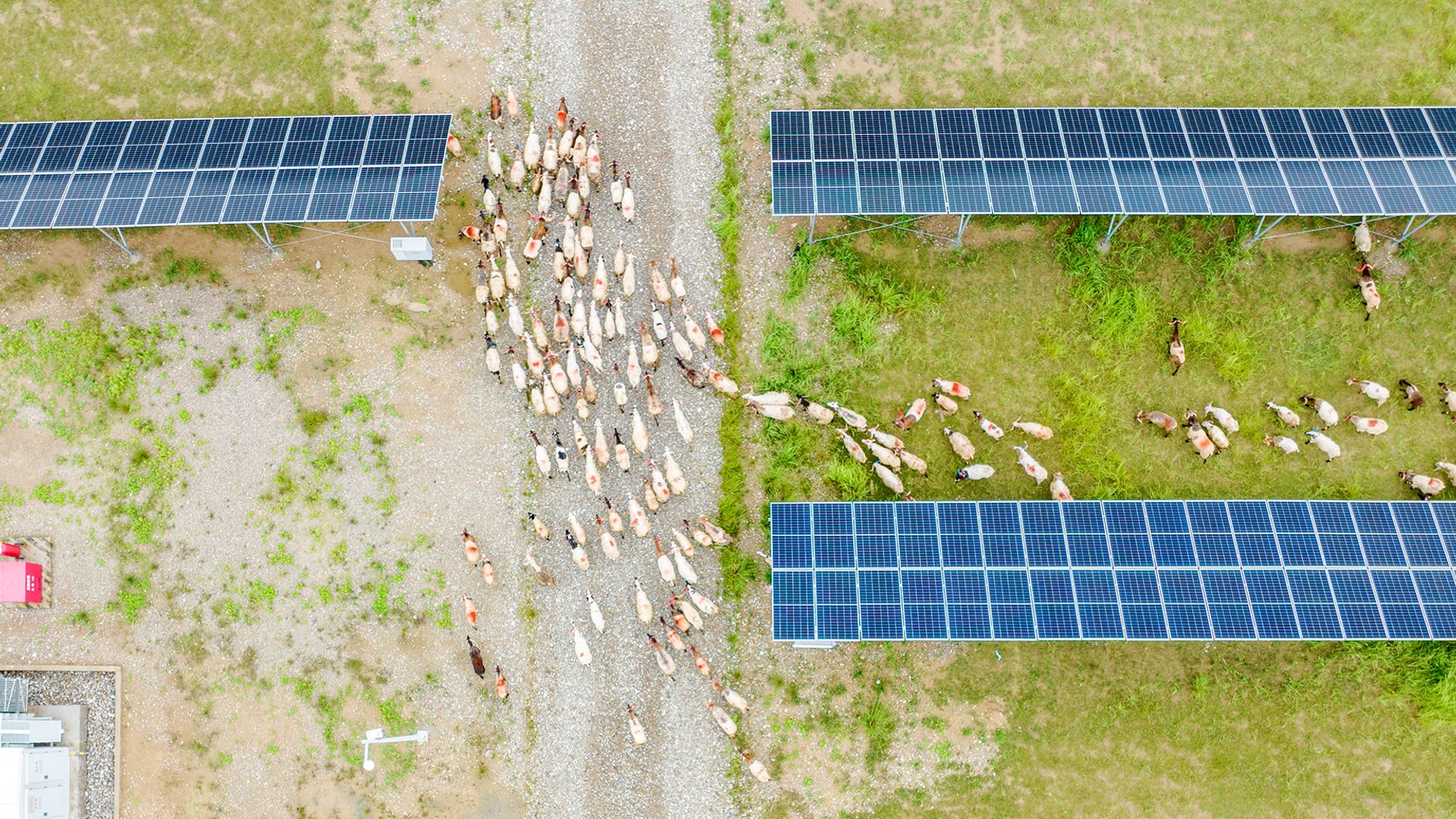
[JACK AYLMER]
THE U.S. HAS A CHOICE TO MAKE.
WILL MILLIONS OF ACRES OF FARMLAND BE DEVOTED TO AGRICULTURE-
OR SOLAR POWER?
WELL, WHY NOT BOTH?
THE AMERICAN FARMLAND TRUST ESTIMATES 83 PERCENT OF SOLAR PROJECTS OVER THE NEXT FEW DECADES WILL BE BUILT ON AGRICULTURAL ACREAGES.
BUT THERE’S A WAY TO USE THESE LANDS TO GENERATE ELECTRICITY AND RAISE LIVESTOCK AT THE SAME TIME.
IT’S CALLED SOLAR-GRAZING.
[LEXIE HAIN]
“So our concept is you’re producing food and fiber in that same acre as you’re producing clean, renewable energy.”
[JACK AYLMER]
TO MAKE THIS HAPPEN, SOLAR PANELS ARE RAISED AROUND SEVEN FEET ABOVE THE GROUND.
ANIMALS LIKE COWS AND SHEEP ARE THEN ABLE TO GRAZE BENEATH AND AROUND THEM.
THE PANELS ARE ALSO TILTED AT AN ANGLE TO ALLOW FOR WATER TO FLOW UNDERNEATH, ALLOWING THE VEGETATION THERE TO CONTINUE GROWING.
[LEXIE HAIN]
“When you’ve got a worker spending hours crouched under solar panels with wiring, it’s all electrified, and eventually people hit their heads. So why don’t you use sheep that can just walk right underneath?”
[JACK AYLMER]
THIS ARRANGEMENT FINANCIALLY HELPS BOTH FARM OWNERS AND UTILITY PROVIDERS.
SOME ENERGY COMPANIES PAY 25-THOUSAND DOLLARS A YEAR ON JUST MOWING THE GRASS AROUND THEIR SOLAR PANELS.
WITH SOLAR GRAZING- THOSE COSTS could be REDUCED BY UP TO 75 PERCENT IN SOME CASES.
[LEXIE HAIN]
“We think this is an amazing opportunity to to bring two industries together. Let’s bring together the renewable energy industry and let’s bring together farmers and agriculturalists and make this a success.”
[JACK AYLMER]
AND RESEARCH GROUPS FOUND THAT FOR EVERY ACRE DEVOTED TO SOLAR GRAZING, FARMERS MAKE BACK AS MUCH AS 500 DOLLARS ANNUALLY.
SO WITH AN AVERAGE SIZED SOLAR INSTALLATION TYPICALLY TAKING UP ABOUT 40 ACRES OF LAND, THAT COULD TRANSLATE TO ABOUT A 20-THOUSAND-DOLLAR PROFIT.
[LEXIE HAIN]
“Solar is being built in rural America. And it is being built actually at scales where they you can have a sizable flock and a sizable income from that.”
[JACK AYLMER]
THE CONCEPT OF SOLAR GRAZING can also make people more receptive to solar energy.
Recent polling shows RESPONDENTS were 80% more likely to support building a solar farm.
POWERING OUR NATION’S FUTURE WITH RENEWABLE ENERGY CAN SOMETIMES MEAN UTILIZING SOME CREATIVE SOLUTIONS LIKE SOLAR GRAZING. TO LEARN ABOUT OTHER WAYS DIFFERENT INDUSTRIES ARE ADAPTING AROUND THE GREEN TRANSITION, DOWNLOAD THE STRAIGHT ARROW NEWS APP AND SIGN UP FOR ALERTS FROM ME- JACK AYLMER- FOR MORE.







